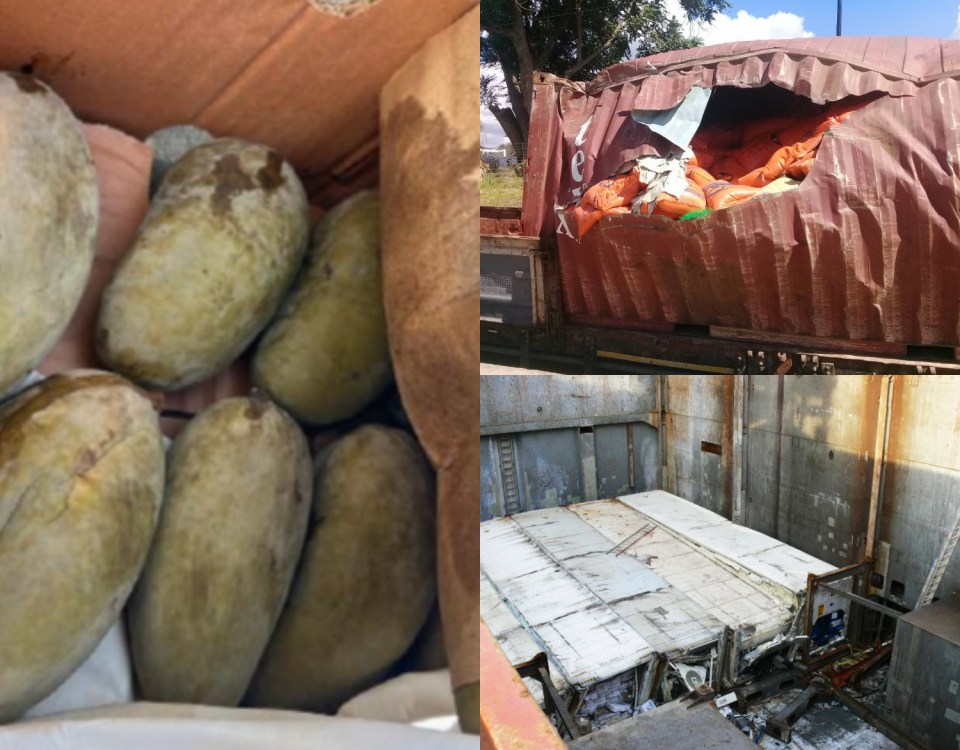How to ensure your dry cargo claim is paid?

6 Steps to Take When You Discover Cargo Damage
June 20, 2025
10 Biggest Follow-up Mistakes in Cargo Claims.
July 25, 2025Reasons Why Dry Cargo Claims Are Rejected
Here is a list of the top reasons why claims are rejected by shipping lines:
- Inability to prove water ingress to a container – shipping line rejects claim based on condensation.
- Late claim notification of damages or potential loss of cargo – shipping line will reject claim if notification is not given within 3 days of from delivery date of container (this one is easy to defend!).
- Documentation not in order – if your documents are not in order, shipping line will reject based on insufficient evidence.
- Photographic evidence – shipping line will reject a claim if it cannot be proven that cargo was packed in that specific container.
- Time bar – shipping line will reject any claim that has gone beyond the time bar period unless you have applied for an extension. The time period will begin on date of delivery of the container.
Understanding Water Content
Let us take coffee as an example. A major reason that coffee claims with water ingress to the container are so often rejected is for reason of “condensation”. Here we have tried to explain simply, the reasons for condensation from coffee within a container.
Coffee is what is called Hygroscopic. This means that it is a product with a variable water content. Hygroscopic products are capable of absorbing water vapor from the air and releasing it back again (this is called sweating), causing water droplets on the roof of the container which then drip onto the coffee sacks where the water is absorbed.
If coffee has an excessively high-water content it may result in mold, rot and biochemical changes. There is a risk of sweating if containers are shipped from a warm region to a cold climate and not quickly unpacked.
Is condensation visible?
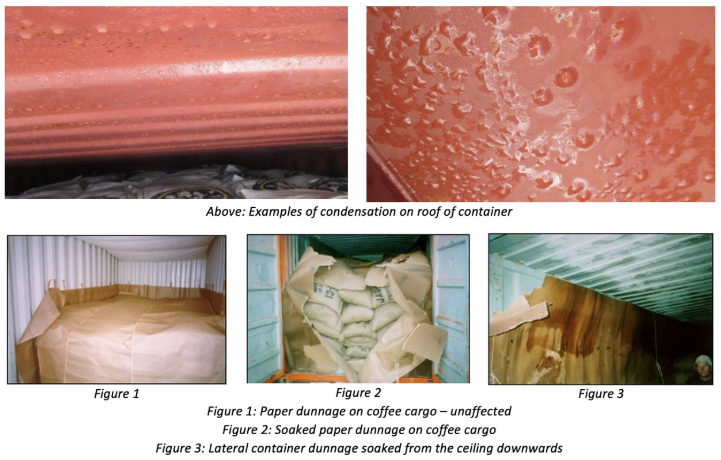
The sad true is that shipping lines tend to reject all coffee claims alleging condensation damage. Regardless if it is true or not, let’s look at ways to defend coffee claims.
Pre-shipment Survey
It is possible to do a pre-shipment survey for FREE! Here’s how: Your supplier is on your team! In order to ensure for cargo is paid in a timely manner and in full, it makes sense that the exporter, your supplier, would want the cargo to be delivered in good order.
Therefore to prove that supplier packed and loaded the cargo in good order at origin, they could issue pre-shipment survey, which is a simple one!
Purpose of Pre-shipment Survey
The purposes of a pre-shipment survey are evident yet rarely it is done:
- Establish condition of the container provided by the shipping line.
- Document how cargo is stuffed into container and prove proper packing and dunnage were used to prevent damage to cargo and container during transit.
- Document state of packaging (sacks) at time of stuffing, proving all cargo was dry at that time.
Proper documentation of the above will include written notes (transferred to letterhead) as well as photographic evidence (remember that a date stamped photograph is far more useful in a cargo claim).
Container Survey
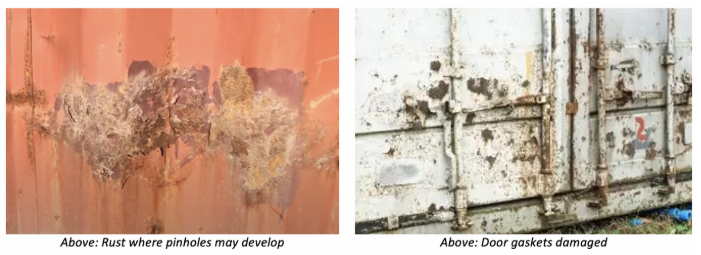
Let’s face it, every container has issues, which shipping lines deny. Often the person you are making a claim with is sitting in an office having never entered a container in their life, so don’t understand the issues faced when being presented with a sub-standard container.
Shipping lines, in order to save money, carry out improper repairs to containers; they also, sometimes do not have the capacity to make proper repairs to damaged containers at local container storage depots. Therefore, to prove that the shipping line has provided a container with issues (multiple patching, fixed floor) we need to document them prior to stuffing the container.
For every container, a light test should be conducted. This involves entering the container, closing the doors completely and evidencing any light infiltration into the container. Often, when there is rust, tiny pinholes, not visible unless a light test is conducted, have penetrated the rust and will allow water ingress to a container. You will also be able to witness any light infiltration to the container around the doors and between floor boards.
If container is in really bad condition, shipper must refuse it and request replacement. Pre-shipment survey also act as evidence of container being clean and look like in sound condition at the time of loading.
Cargo and Loading Survey
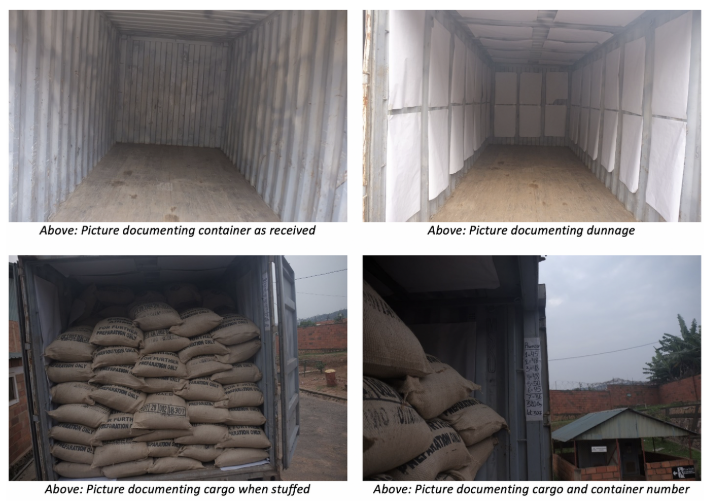
Documentary evidence of cargo as well as packaging and dunnage is important. With cargo of coffee, obviously the actual beans cannot be photographed as sacks are sealed, so it is very important to document the state of the in order to prove cargo was loaded in good order and packages were not showing any water damage, holes, etc.
Notes should be taken of state of cargo at time of loading on the same report. In order to prove good packing of container, further documentary evidence should be taken. Listing type of packages being loaded, how they are loaded, and what dunnage is used to secure and protect the cargo is very important. Example:
- Container internal panels affixed with paper for condensation absorption; 50kg bags of coffee loaded 6 bags wide by 15 bags high.
Photographic evidence of the same should be taken throughout the loading process, as well as after loading is complete and doors are sealed. Photographs should show the container number on the inside panel of the container or on the internal roof by the doors as well as the cargo, this links a particular container with that particular cargo.
Post-shipment Survey
The primary reason why shipping lines reject any claim notification submitted after 3 days from date of delivery is based on The Hague and Hague/Visby Rules art. 3(6), stated below:
“Unless notice of loss or damage and the general nature of such loss or damage be given in writing to the carrier or his agent at the port of discharge before or at the time of the removal of the goods into the custody of the person entitled to delivery thereof under the contract of carriage, or, if the loss or damage be not apparent, within three days, such removal shall be prima facie evidence of the delivery by the carrier of the goods as described in the bill of lading.”
As it is almost impossible for a cargo receiver to know if cargo is inside the container is damaged within 3 days. It has become industry practice for shippers to notify shipping line before cargo arrival or within 3 days after delivery about the potential damage and invite them to attend de-stuffing at the receiver’s warehouse (regardless if the receiver appoints the surveyor or not, regardless if the cargo has actually been damaged or not).
The Survey Report
As you should have a copy of the pre-shipment survey and have viewed the photographs taken at the time of stuffing, you should have a fair idea of what to expect when you receive the container. You will know where potential problems may lie.
- Try to show the position of where the damaged cargo is in the container, i.e. bottom layer of coffee sacks wet, top layer wet, coffee bags in one corner wet, etc.
- It is not helpful to only have pictures of damaged cargo outside the container. Shipping lines will reject as you cannot prove that the cargo was destuffed from a specific container.
- Ensure you take enough clear photographs of container damage, holes, etc. before you return the container to the yard or depot.
- Always take at least 1 photograph of the inside of the container roof to disprove condensation. See below examples of condensation.
- If you can digitally date and time stamp your photographs this would be even better.
- Submit your photographs to the shipping line immediately with your claim.
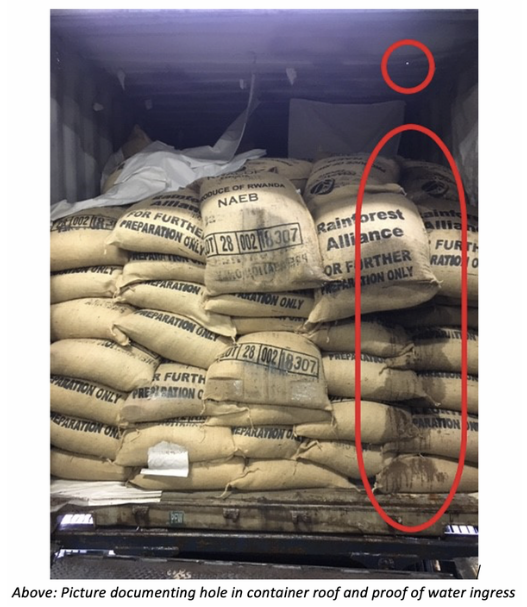
Claim Documents
It’s all about the documentation! If your documents are not in order, the claim game becomes very difficult.
Essential Documents
Having already sent the potential claim notification letter, discussed above, below is a list of documents which must be submitted as part of your claim to the shipping line as soon as you can:
- Bill of Lading (BL)
- Packing List
- Commercial Invoice
- Photographic evidence, as outlined above.
- Claim letter giving description of damage, i.e. water damage (water ingress or flooding), physical damage (container mishandled during loading or discharging operations), cargo loss (cargo pilferage mainly).
- In the same letter, give a loss breakdown. Legally, shipping lines have to reimburse sound market value (if you can prove) or commercial invoice value, freight, and cargo insurance if the cargo was insured. Please bear in mind that survey fees are not recoverable.
There may be other documents which may not be immediately available to you, but are still part of the claim, you can submit these at a later date:
- Surveyor’s report (If done).
- Proof that you mitigated loss (salvage invoice) or evidence that cargo is a total loss (destruction certificate).
Time Limitation or Time Bar
All claims will be subject to limitations of time. It is your responsibility (as the claimant) to review the BL terms and familiarise yourself with the applicable limitation of time. In the event that it is not possible for the claim to be resolved within the limitation of time, an extension of time may be requested.
The countdown starts on the day of delivery at the receiver’s warehouse. Most claims are time barred after one year, but this may differ from country to country, so it is always good to check the BL terms and applicable international conventions.
Summary
To start winning and getting your dry cargo claim paid, you need to remember the following in this order:
1. Pre-shipment survey with photographs.
2. Claim notification sent within 3 days of cargo delivery.
3. Post-shipment survey with photographs.
4. Documentation.

